- ▶
- Heaters/Source
- ▶
- Agilent Heaters and SensorsMass Spectrometry, Scientific Supplies & ManufacturingScientific Instrument Services 5973 Source Heater Tamper Resistant Allen Wrench 5973/5975 Quad Sensor 5985 Source Heater Assembly Agilent Interface Heater Assembly 5971 Interface Heater

- ▶
- LiteratureApplication Notes Adsorbent Resins Guide Mass Spec Tips SDS Sheets FAQ MS Calibration Compound Spectra Manuals MS Links/Labs/ Organizations MS Online Tools Flyers on Products/Services Scientific Supplies Catalog About Us NextAdvance Bullet Blender® Homogenizer Protocols Micro-Mesh® Literature Instrumentation Literature Agilent GC/MS Literature SIS News / E-Mail Newsletter NIST MS Database - Update Notifications

- ▶
- Application NotesNote 103: EPA Method 325B, Novel Thermal Desorption Instrument Modification to Improve Sensitivity Note 102: Identification of Contaminants in Powdered Beverages by Direct Extraction Thermal Desorption GC/MS Note 101: Identification of Contaminants in Powdered Foods by Direct Extraction Thermal Desorption GC/MS Note 100: Volatile and Semi-Volatile Profile Comparison of Whole Versus Cracked Versus Dry Homogenized Barley Grains by Direct Thermal Extraction Note 99: Volatile and Semi-Volatile Profile Comparison of Whole vs. Dry Homogenized Wheat, Rye and Barley Grains by Direct Thermal Extraction GC/MS Note 98: Flavor and Aroma Profiles of Truffle Oils by Thermal Desorption GC/MS Note 97: Flavor Profiles of Imported and Domestic Beers by Purge & Trap Thermal Desorption GC/MS Note 96: Reducing Warping in Mass Spectrometer Filaments, with SISAlloy® Yttria/Rhenium Filaments Note 95: Detection of Explosives on Clothing Material by Direct and AirSampling Thermal Desorption GC/MS Note 94: Detection of Nepetalactone in the Nepeta Cataria Plant by Thermal Desorption GC/MS Note 93: Detection of Benzene in Carbonated Beverages with Purge & Trap Thermal Desorption GC/MS Note 92: Yttria Coated Mass Spectrometer Filaments Note 91: AutoProbe DEP Probe Tip Temperatures Note 90: An Automated MS Direct Probe for use in an Open Access Environment Note 89: Quantitation of Organics via a Mass Spectrometer Automated Direct Probe Note 88: Analysis of Silicone Contaminants on Electronic Components by Thermal Desorption GC-MS Note 87: Design and Development of an Automated Direct Probe for a Mass Spectrometer Note 86: Simulation of a Unique Cylindrical Quadrupole Mass Analyzer Using SIMION 7.0. Note 85: Replacing an Electron Multiplier in the Agilent (HP) 5973 MSD Note 84: Vacuum Pump Exhaust Filters - Charcoal Exhaust Traps Note 83: Vacuum Pump Exhaust Filters - Oil Mist Eliminators Note 82: Vacuum Pump Exhaust Filters Note 81: Rapid Bacterial Chemotaxonomy By DirectProbe/MSD Note 80: Design, Development and Testing of a Microprocessor ControlledAutomated Short Path Thermal Desorption Apparatus Note 79: Volatile Organic Compounds From Electron Beam Cured and Partially Electron Beam Cured Packaging Using Automated Short Path Thermal Desorption Note 78: A New Solution to Eliminate MS Down-Time With No-Tool-Changing of Analytical GC Columns Note 77: The Determination of Volatile Organic Compounds in VacuumSystem Components Note 76: Determination of the Sensitivity of a CRIMS System Note 75: An Apparatus for Sampling Volatile Organics From LivePlant Material Using Short Path Thermal Desorption Note 74: Examination of Source Design in Electrospray-TOF Using SIMION 3D Note 73: The Analysis of Perfumes and their Effect on Indoor Air Pollution Note 72: 1998 Version of the NIST/EPA/NIH Mass Spectral Library, NIST98 Note 71: Flavor Profile Determination of Rice Samples Using Shor tPath Thermal Desorption GC Methods Note 70: Application of SIMION 6.0 To a Study of the Finkelstein Ion Source: Part II Note 69: Application of SIMION 6.0 To a Study of the Finkelstein Ion Source: Part 1 Note 68: Use of a PC Plug-In UV-Vis Spectrometer To Monitor the Plasma Conditions In GC-CRIMS Note 67: Using Chemical Reaction Interface Mass Spectrometry (CRIMS) To Monitor Bacterial Transport In In Situ Bioremediation Note 66: Probe Tip Design For the Optimization of Direct Insertion Probe Performance Note 65: Determination of Ethylene by Adsorbent Trapping and Thermal Desorption - Gas Chromatography Note 64: Comparison of Various GC/MS Techniques For the Analysis of Black Pepper (Piper Nigrum) Note 63: Determination of Volatile and Semi-Volatile Organics in Printer Toners Using Thermal Desorption GC Techniques Note 62: Analysis of Polymer Samples Using a Direct Insertion Probe and EI Ionization Note 61: Analysis of Sugars Via a New DEP Probe Tip For Use With theDirect Probe On the HP5973 MSD Note 60: Programmable Temperature Ramping of Samples Analyzed ViaDirect Thermal Extraction GC/MS Note 59: Computer Modeling of a TOF Reflectron With Gridless Reflector Using SIMION 3D Note 58: Direct Probe Analysis and Identification of Multicomponent Pharmaceutical Samples via Electron Impact MS Note 57: Aroma Profiles of Lavandula species Note 56: Mass Spec Maintenance & Cleaning Utilizing Micro-Mesh® Abrasive Sheets Note 55: Seasonal Variation in Flower Volatiles Note 54: Identification of Volatile Organic Compounds in Office Products Note 53: SIMION 3D v6.0 Ion Optics Simulation Software Note 52: Computer Modeling of Ion Optics in Time-of-Flight mass Spectrometry Using SIMION 3D Note 51: Development and Characterization of a New Chemical Reaction Interface for the Detection of Nonradioisotopically Labeled Analytes Using Mass Spectrometry (CRIMS) Note 50: The Analysis of Multiple Component Drug Samples Using a Direct Probe Interfaced to the HP 5973 MSD Note 49: Analysis of Cocaine Utilizing a New Direct Insertion Probe on a Hewlett Packard 5973 MSD Note 48: Demonstration of Sensitivity Levels For the Detection of Caffeine Using a New Direct Probe and Inlet for the HP 5973 MSD Note 47: The Application Of SIMION 6.0 To Problems In Time-of-Flight Mass Spectrometry Note 46: Delayed Extraction and Laser Desorption: Time-lag Focusing and Beyond Note 45: Application of SIMION 6.0 to Filament Design for Mass Spectrometer Ionization Sources Note 44: The Design Of a New Direct Probe Inlet For a Mass Spectrometer Note 43: Volatile Organic Composition In Blueberries Note 42: The Influence of Pump Oil Purity on Roughing Pumps Note 41: Hydrocarbon Production in Pine by Direct Thermal Extraction Note 40: Comparison of Septa by Direct Thermal Extraction Note 39: Comparison of Sensitivity Of Headspace GC, Purge and Trap Thermal Desorption and Direct Thermal Extraction Techniques For Volatile Organics Note 38: A New Micro Cryo-Trap For Trapping Of Volatiles At the Front Of a GC Capillary Column Note 37: Volatile Organic Emissions from Automobile Tires Note 36: Identification Of Volatile Organic Compounds In a New Automobile Note 35: Volatile Organics Composition of Cranberries Note 34: Selection Of Thermal Desorption and Cryo-Trap Parameters In the Analysis Of Teas Note 33: Changes in Volatile Organic Composition in Milk Over Time Note 32: Selection and Use of Adsorbent Resins for Purge and Trap Thermal Desorption Applications Note 31: Volatile Organic Composition in Several Cultivars of Peaches Note 30: Comparison Of Cooking Oils By Direct Thermal Extraction and Purge and Trap GC/MS Note 29: Analysis Of Volatile Organics In Oil Base Paints By Automated Headspace Sampling and GC Cryo-Focusing Note 28: Analysis Of Volatile Organics In Latex Paints By Automated Headspace Sampling and GC Cryo-Focusing Note 27: Analysis of Volatile Organics In Soils By Automated Headspace GC Note 26: Volatile Organics Present in Recycled Air Aboard a Commercial Airliner Note 25: Flavor and Aroma in Natural Bee Honey Note 24: Selection of GC Guard Columns For Use With the GC Cryo-Trap Note 23: Frangrance Qualities in Colognes Note 22: Comparison Of Volatile Compounds In Latex Paints Note 21: Detection and Identification Of Volatile and Semi-Volatile Organics In Synthetic Polymers Used In Food and Pharmaceutical Packaging Note 20: Using Direct Thermal Desorption to Assess the Potential Pool of Styrene and 4-Phenylcyclohexene In Latex-Backed Carpets Note 19: A New Programmable Cryo-Cooling/Heating Trap for the Cryo-Focusing of Volatiles and Semi-Volatiles at the Head of GC Capillary Columns Note 18: Determination of Volatile Organic Compounds In Mushrooms Note 17: Identification of Volatile Organics in Wines Over Time Note 16: Analysis of Indoor Air and Sources of Indoor Air Contamination by Thermal Desorption Note 14: Identification of Volatiles and Semi-Volatiles In Carbonated Colas Note 13: Identification and Quantification of Semi-Volatiles In Soil Using Direct Thermal Desorption Note 12: Identification of the Volatile and Semi-Volatile Organics In Chewing Gums By Direct Thermal Desorption Note 11: Flavor/Fragrance Profiles of Instant and Ground Coffees By Short Path Thermal Desorption Note 10: Quantification of Naphthalene In a Contaminated Pharmaceutical Product By Short Path Thermal Desorption Note 9: Methodologies For the Quantification Of Purge and Trap Thermal Desorption and Direct Thermal Desorption Analyses Note 8: Detection of Volatile Organic Compounds In Liquids Utilizing the Short Path Thermal Desorption System Note 7: Chemical Residue Analysis of Pharmaceuticals Using The Short Path Thermal Desorption System Note 6: Direct Thermal Analysis of Plastic Food Wraps Using the Short Path Thermal Desorption System Note 5: Direct Thermal Analysis Using the Short Path Thermal Desorption System Note 4: Direct Analysis of Spices and Coffee Note 3: Indoor Air Pollution Note 2: Detection of Arson Accelerants Using Dynamic Headspace with Tenax® Cartridges Thermal Desorption and Cryofocusing Note 1: Determination of Off-Odors and Other Volatile Organics In Food Packaging Films By Direct Thermal Analysis-GC-MS Tech No. "A" Note 14: Elimination of "Memory" Peaks in Thermal Desorption Improving Sensitivity in the H.P. 5971 MSD and Other Mass Spectrometers - Part I of II Improving Sensitivity in the H.P. 5971 MSD and Other Mass Spectrometers- Part II of II Adsorbent Resins Guide Development and Field Tests of an Automated Pyrolysis Insert for Gas Chromatography. Hydrocarbon Production in Pine by Direct Thermal Extraction A New Micro Cryo-Trap for the Trapping of Volatiles at the Front of a GC Capillary (019P) - Comparison of Septa by Direct Thermal Extraction Volatile Organic Composition in Blueberry Identification of Volatile Organic Compounds in Office Products Detection and Indentification of Volatiles in Oil Base Paintsby Headspace GC with On Column Cryo-Trapping Evaluation of Septa Using a Direct Thermal Extraction Technique INFLUENCE OF STORAGE ON BLUEBERRY VOLATILES Selection of Thermal Desorption and Cryo-Trap Parameters in the Analysis of Teas Redesign and Performance of a Diffusion Based Solvent Removal Interface for LC/MS The Design of a New Direct Probe Inlet for a Mass Spectrometer Analytes Using Mass Spectrometry (CRIMS) Application of SIMION 6.0 to Filament Design for Mass Spectrometer Ionization Sources A Student Guide for SIMION Modeling Software Application of SIMION 6.0 to Problems in Time-of-flight Mass Spectrometry Comparison of Sensitivity of Headspace GC, Purge and TrapThermal Desorption and Direct Thermal Extraction Techniques forVolatile Organics The Influence of Pump Oil Purity on Roughing Pumps Analysis of Motor Oils Using Thermal Desorption-Gas Chromatography-Mass Spectrometry IDENTIFICATION OF VOLATILE ORGANIC COMPOUNDS IN PAPER PRODUCTS Computer Modeling of Ion Optics in Time-of-Flight mass Spectrometry using SIMION 3D Seasonal Variation in Flower Volatiles Development of and Automated Microprocessor Controlled Gas chromatograph Fraction Collector / Olfactometer Delayed Extraction and Laser Desorption: Time-lag Focusing and Beyond A New Micro Cryo-Trap for the Trapping of Volatiles at the Front of a GC Column Design of a Microprocessor Controlled Short Path Thermal Desorption Autosampler Computer Modeling of Ion Optics in Time-of-Flight Mass Spectrometry Using SIMION 3D Thermal Desorption Instrumentation for Characterization of Odors and Flavors

- ▶
- Tech No. "A" (This Page)
Technical Bulletin No. 1 October 1990
Part I - Design & Operation of the Short Path Thermal Desorption System
John J. Manura
Scientific Instrument Services, Ringoes, NJ
Figure 1 - The Short Path Thermal Desorption System, Model TD1.
Introduction
A new accessory for the thermal desorption and direct thermal analysis of samples into a Gas Chromatograph (GC) has just been introduced by Scientific Instrument Services, Inc. (S.I.S.) This new instrument is the combined effort of Scientific Instrument Services, Inc. and Rutgers University, Center for Advanced Food Technology (CAFT), who have jointly applied for a patent on the Short Path Thermal Desorption System and technique. The Short Path Thermal Desorption System is currently being manufactured in the facilities of S.I.S. and is being shown at the March 1991 Pittsburgh Conference in Chicago.
The technique of Short Path Thermal Desorption involves the desorption of volatile and semi-volatile organics collected on adsorbent resins in a small sample tube directly into the injection port of the Gas Chromatograph. By making the transfer path as short as possible, the maximum sample size is delivered to the GC, samples are not lost or destroyed in hot transfer lines, and no memory effects occur due to contamination of transfer lines from previous samples. The technique and original design were developed by Dr. Thomas Hartman of Rutgers University, Center for Advanced Food Technology.
An alternate method of analysis using the Short Path Thermal Desorption System is called Direct Thermal Analysis. This technique permits the analysis of low moisture content samples which have been placed directly in the Glass Lined Stainless Steel (GLT) Desorption Tubes. Samples such as spices, paint chips, packaging films, pharmaceuticals, pine needles, and fibers can be analyzed directly using this technique. Water vapor must be minimized since it will condense and plug the GC column. Alternatively, adsorbent materials such as Tenax®, Carbowax, Porapak or Carbotrap can be used for high moisture containing samples.
The technique of Short Path Thermal Desorption has been developed to permit the analysis of organic compounds present in air or compounds which can be easily purged from solid and liquid samples. Samples such as volatile and semi-volatile organics in air, flavors and fragrances in foods and cosmetics, manufacturing chemical residues in pharmaceuticals, volatiles in packaging materials and building products, and aromatic residues in Forensic arson samples are just a few of the applications for which this technique has been utilized. Additionally, the technique has been applied for specific applications such as the detection of benzene and chlorinated hydrocarbons in food and other manufactured products, the identification of natural occurring insect repellents in plants, the identification of flavors in black pepper and other spices, and the identification of volatile contaminants in commercial shipping containers. The technique eliminates the need for solvent extractions in many analysis.
Theory of Operation
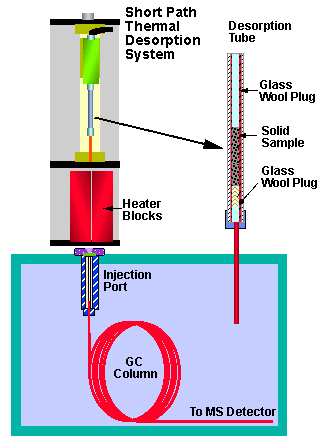
Figure 2 - The Short Path Thermal Desorption, Theory of Operation
Samples to be analyzed are collected on GLT Desorption Tubes containing an adsorbent resin such as Tenax TA or activated carbon. When ready for analysis the GLT Desorption Tubes are fitted with a syringe needle and attached to the Desorption Unit (Figure # 2). This permits the trapped samples to be heated by the Desorption Tube Heater Blocks, desorbed from the adsorbent resin and injected directly into the injection port of a GC, GC/MS or GC/FTIR via the shortest path possible, i.e. direct injection into the GC much like a syringe. The GC column, either capillary or packed, is normally maintained at subambient temperatures (or at a low enough temperature to retain any samples at the front of the GC column) during the initial desorbing of the sample into the GC. This enables the desired components to be collected in a narrow band on the front of the GC column over a long period of time (5 to 15 minutes). As an alternative to cryofocusing, the same effect can be achieved by using a thick film capillary column or a packed column with a high loading capacity. These are available at numerous chromatography houses. When the sample has been fully desorbed into the GC column, temperature programming is commenced to volatilize the organics and to elute and separate them into the desired components.
The Short Path Thermal Desorption System provides several unique advantages over other desorption type systems:
First, it enables the sample, which is trapped in an adsorbent media contained in a GLT Desorption Tube, to be subjected to rapid heating.
Second, the desorbed component can be easily and efficiently transferred into the injection port of the gas chromatograph from a glass lined stainless steel sample tube and its associated injection needle. This provides for a short transfer path for the sample in an inert environment to minimize the degradation of labile sample components which often decompose upon contact with the hot catalytic metal wall surfaces of the transfer path of other systems.
Third, each sample has its own individual adsorbent trap tube and needle to eliminate the possibility of cross-contamination from sample to sample, thus preventing any Memory effect due to overloading of the sample in the GLT Desorption Tube or due to residues from previous samples.
The Short Path Thermal Desorption System consists of two modules, i.e. an Electronic Control Unit and the Desorption Unit (Figure # 1).
The Thermal Desorption Unit sits directly over the GC injection port. The septum nut of the GC slips into a groove in the bottom plate of the Desorption Unit to correctly align the system for injection. No mounting hardware, screws or bolts are required to install the Desorption System. On some GC's, it may be necessary to add an accessory plate around the injection port to provide a stable base on which the Desorption Unit can sit. The septum nut groove and the weight of the unit hold the Desorption Unit in place during injection and analysis of samples. The Desorption Unit can be easily lifted off the injection port of the GC for conventional injection of samples via syringe or autosamplers, and can be easily slipped back onto the GC injection port nut for desorbing samples into the injection system.
The Electronics Console connects to the Desorption Unit via a single electronics cable. The Electronics Console contains the temperature controller, digital timer, and switches to control the heating and cooling of the Desorption Tube, providing for the injection of the Desorption Tube into the GC, and controls the carrier gas flow through the Desorption Tube.
Description of Desorption Unit
The Thermal Desorption Unit (Figure # 3) is designed as a compact self contained injection system and Desorption System that mounts directly over the GC injection port. The air powered Autoinjector permits the user to inject the Desorption Tube with needle attached into the GC injection port by means of a switch on the Electronics Console. The Desorption Tube with syringe needle is attached to the Autoinjector Assembly and carrier gas flows through the Desorption Tube and needle continuously when activated by the appropriate switch on the Electronics Console. The carrier gas flow through the Desorption Tube is regulated by a Flow Controller Valve mounted on the top of the Desorption Unit. The flow can be monitored by either a two ball rotameter mounted on the right side of the Desorption Unit or via a pressure gauge mounted on the left side. The rotameter enables the measurement of carrier gas flows between 1 and 120 ml/min. The pressure gauge permits the measurement of carrier gas pressures at the top of the Desorption Tube between 0 and 60 psi. The viewport at the front bottom of the Desorption Unit permits the easy viewing of the injection port and Desorption Tube when injected and also provides for cooling of the Desorption Tube when the desorption heater block is not activated. It can be easily viewed that the syringe needle is proceeding properly into the GC injection port and that the Desorption Unit is properly aligned.
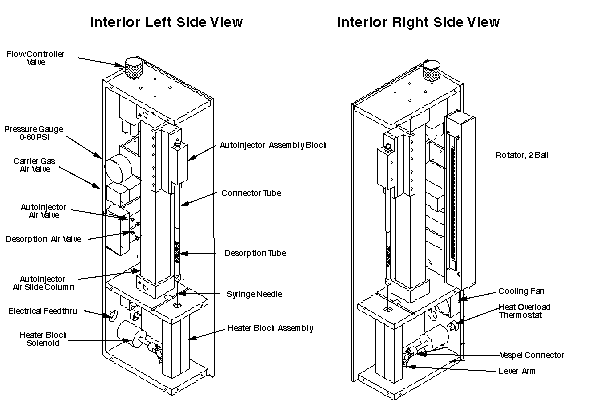
Figure 3 - The Short Path Thermal Desorption Unit Components
The Desorption Unit is designed as a compact system with a wide variety of components built into the Desorption Unit Case (Figure # 3). The Carrier Gas Flow System inside the Desorption Cabinet consists of an air valve, a flow controller, a pressure gauge, and a two-ball rotameter. The Autoinjecting System consists of an air valve, an Autoinjector Air Slide Column, and assembly block. The Desorbing System consists of an air valve, an air solenoid, and the Heater Block Assembly. In addition a cooling fan maintains the temperature inside the cabinet and a heat overload thermostat provides protection from system overheating.
The drawings in Figure # 4 show the Desorption Unit with the sides, top and front plates removed to provide a visual representation of the operation of the Desorption Unit.
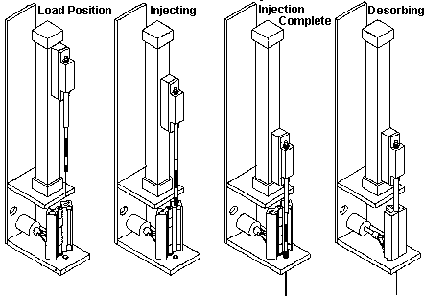
Figure 4 - The Short Path Thermal Desorption Unit Mechanism
When ready to be analyzed, a syringe needle is attached to the Desorption Tube which is then attached to the Connector Tube on the Autoinjector Assembly of the Desorption Unit (LOAD POSITION). The carrier gas through the Desorption Unit is turned on at the Electronics Console and the flow through the Desorption Tube is adjusted via the flow controller, rotameter and/or the pressure gauge.
The Electronics Console is activated to inject the Desorption Tube with needle attached (INJECTING). The Desorption Tube will pass through the opening in the middle plate of the Desorption Unit base to position the Desorption Tube in proper alignment with the GC injection port and the normally open Desorption Block Assembly.
When injection is complete (INJECTION COMPLETE), the flows are readjusted as required by the method of analysis, i.e. split/splitless, etc. In this position the sample is not being desorbed into the GC since the Heating Block is not in contact with the Desorption Tube. The temperature of the tube remains close to room temperature due to the action of the cooling fan, which pulls in room air from the front of the Desorption Unit, through the view port and across the Desorption Tube. Carrier gas flows, desorption temperatures, and GC parameters can be adjusted as required.
The desorption process can then be commenced by activating the desorption switch on the Electronics Console (HEAT & DESORB). This actuates an air valve which delivers air to the air powered solenoid and moves the hinged heating blocks from the open to the closed position around the Desorption Tube. The Desorption Tube will rapidly heat up to the set temperature. The combination of the heat applied and the carrier gas flow through the Desorption Tube will drive the desired components into the GC injection port and onto the front of the GC column.
The various parameters are set and utilized according to the application requirements. Normally desorption temperatures between 70 degrees C and 250 degrees C are suitable for most applications. The maximum desorption temperature permissible with the system is 350 degrees C. The air fan in the base of the Desorption Unit provides for continuing air circulation in the Desorption Unit base. This maintains the temperature at the air solenoid on the back base of the Desorption Unit to less than 60 degrees C. This fan also can permit the Desorption Tube to remain cool or to be cooled when the Desorption Tube with attached needle is left in the down or engaged position and the desorption blocks are left in the open position. In addition, a heat overload thermostat is located on the back of the Desorption Unit base to protect the Desorption Unit from overheating. This thermostat is wired in series with the cartridge heaters. In the event the temperature at the thermostat exceeds 60 degrees C, the circuit will be opened and the heater blocks will no longer be heated until the temperature inside the Desorption Unit falls below this temperature level. Normal desorption times vary from 3 minutes to 15 minutes; however, longer desorption times up to 100 minutes can be performed and are quite acceptable. Since the column is normally maintained at subambient temperatures, the desorbed compounds of interest are trapped on the front of the GC column in a narrow band. Despite the long desorption times, the peaks eluted from the column are extremely sharp and well resolved. Carrier flow through the Desorption Tube can be accurately adjusted from 1.0 ml/min to 120 ml/min using the two ball rotameter depending on the application, i.e. 1.0 ml/min for direct splitless analysis and 100 ml/min for split methods permitting split ratios of 1 to 100.
The use of the Autoinjector, which is controlled by the Electronics Console, permits the injection and removal of the needle assembly from the GC injection port without physically handling the Desorption Tube during the injection process. This is quite important, since the Desorption Tube is often at 250 degrees or higher temperatures after the sample has been desorbed. If the Desorption Tube and needle are left in the GC injection port with the Desorption Tube Heater Blocks left in the open position, the Desorption Tube will also cool in this position. This occurs due to the forced flow of air by the cooling fan in the base of the Desorption Unit.
Heater Block Operation
The Desorption Block Assembly is constructed of two coacting precision formed aluminum heating blocks which have hinged sections that enable the heating blocks to be pivotally connected to each other about a brass hinge pin (Figure # 5). The heating blocks are formed and precision machined from solid blocks of aluminum which have a high coefficient of heat transfer so the Desorption Block Assembly can be quickly heated and cooled during operation of the Short Path Thermal Desorption Unit.
Each of the heating blocks is provided with a conventional 150 watt resistance cartridge heater which are longitudinally inserted in each of the aluminum heating blocks (Figure # 5). The heating cartridge in the aluminum heating blocks are in relatively close proximity to the Desorption Tube to permit accurate ballistic heating of the Desorption Tube to the desired temperatures for time periods from 1 sec to 100 minutes. This close proximity of the heating blocks to their respective resistance heaters enables the Desorption Tube to be rapidly heated and the desired temperature can be maintained within +/-1%. The Desorption Block Assembly also includes a 100 ohm platinum resistance thermometer mounted in one of the aluminum blocks which provides feedback to enable the Electronic Controller to regulate the temperature as well as provide an accurate temperature indication for the Desorption Block Assembly on the digital readout on Electronics Controller.
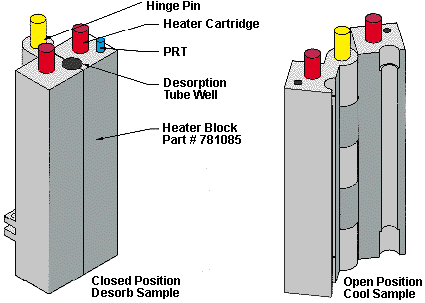
Figure 5 - Desorption Heater Block Assembly
Carrier Gas Flow & Regulation
In the Short Path Thermal Desorption Unit, carrier gas is used for the operation of the Injection Assembly to aid the desorption of the sample component from the Desorption Tube. Carrier gas for this purpose preferably will be helium or nitrogen. In no case should hydrogen be used, due to the high temperatures and possibility of explosion.
Carrier gas from a suitable source such as a gas pressure cylinder with appropriate regulators, air cleaners and oxygen scrubbers delivers clean gas to the carrier gas inlet at the back of the Desorption Unit base. (Figure # 6) The carrier gas is then directed to a two way valve. This valve is controlled by the carrier gas switch on the Electronics Console which can be activated to open or close this valve.
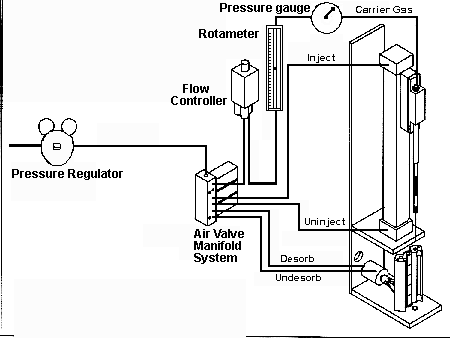
Figure 6 - Gas Flow Schematic
The carrier gas flow regulator is utilized to adjust the flow within the range of 1 to 120 ml/min. This high precision flow regulator is normally equipped with a flow plug with a maximum flow capacity of 110 ml/min. Other flow plugs for flow ranges of 10 ml/min, 25 ml/min, and 400 ml/min are also available. The flow range is changed by unscrewing the color coded plug from the base of the flow controller inside the Desorption Unit, and replacing it with a new flow plug of the correct size.
A two ball rotameter is mounted on the right side of the Thermal Desorption Unit and permits the visual indication and adjustment of the carrier gas flow. The 150 mm long flow tube contains a glass ball for flow ranges of 0 to 30 ml/min of air and a second carboloy ball for flow ranges of 0 to 130 ml/min of air. This unique two ball design rotameter permits the accurate measurement of flows over a wider range of flows than other single ball rotameters. In addition, the two sided viewing permits the inspection from both the front and side depending on the installation position of the Desorption Unit on the GC injection port. If required other flow range tubes can be factory installed in the Desorption Unit.
In addition to permitting the visual regulation of the carrier gas flow through the Desorption Unit, the rotameter is used to sense when problems are occurring in the operation of the Desorption Unit.
For example, in the splitless mode of operation at low flows, the ball in the rotameter normally falls down to zero upon the initial injection of the Desorption Tube syringe into the GC injection port, but will eventually rise back up to its set valve. This is due to the initial surge of backpressure from the gas pressure in the GC injection port. If the rotameter continues to read zero, it indicates that the syringe needle is probably clogged with a plug of septa material and is restricting flow through the syringe assembly.
A 1.5 inch diameter, 60 psi pressure gauge is mounted on the left side of the Desorption Unit. This gauge can be used in conjunction with the pressure gauge on the GC injection port to regulate the operation of the system as well as troubleshoot when problems are occurring such as leaking seals, plugged syringes and bad septa in the GC. The pressure gauge on the Desorption Unit measures the carrier gas pressure at the top of the Desorption Tube. The pressure gauge on the GC measures the pressure in the injection port and, upon injection, the pressure at the bottom of the Desorption Tube. With expertise in the various techniques, distinctive operating parameters will be developed with which the operator can monitor the proper performance of the system. The pressure gauge can be substituted with other range gauges if so desired.
Description of Electronics Console
The Electronics Console consists of a high accuracy keypad operated Temperature Controller to regulate the temperature of the Desorption Tube heater blocks, a digital countdown timer which controls the length of time the sample is to be desorbed (between 1 second and 100 minutes), and several controlling switches. The Main Power Switch controls the power to the entire Desorption System, to the Temperature Controller, timer, and other switches. The Heater Switch turns on the power to the heater cartridges in the Desorption Tube heater blocks and begins their heating cycle. A Platinum Resistance Thermometer (PRT) in the heater blocks provides for accurate (+/- 1¡) temperature readout and also provides the feedback to the Temperature Controller to maintain the heater block temperatures. The Carrier Gas Switch turns on the carrier gas to permit its flow through the Desorption Tube. The Injector Switch activates the air powered injector to inject the Desorption Tube and needle into the GC injection port, and the Desorb Sample Switch closes the Desorption Tube blocks around the Desorption Tube and activates the countdown timer to heat and desorb the residues trapped on the Desorption Tube packing into the GC.
The Electrical Schematics Drawing (Figure # 7) pictorially represents the overall operation of the Electronics System. A 110 volt, 10 amp power source provides the total electric power required by the Electronics Console and Desorption Unit. This provides the power to the Temperature Controller, timer, desorber heater cartridges and DC power supply. The DC power supply in turn provides the power to the air valves in the Desorption Unit to drive the Autoinjector, carrier gas, and close the desorption blocks around the Desorption Tube. It also provides the direct power for the DC fan in the Desorption Unit. The system is double fused. The main fuse controls the incoming power to restrict the total input to less than 10 amps of current. The second fuse is for the heater cartridges in the Desorption Unit.
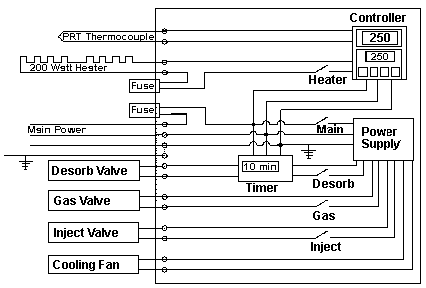
Figure 7 - Electrical Schematics Diagram
A single cable assembly provides the connection between the Electronics Control and the Desorption Unit. This cable has two screw on connectors on each end which screw into the fittings located on each of the two assemblies. The cable can be used reversibly since the connectors on both ends are identical. The cable contains (1) two 115 volt lines for the heater cartridges, (2) two leads for the platinum resistance thermometer, (3) two leads for the carrier gas air valve, (4) two leads for the cooling fan, (5) two leads for the Autoinjector, (6) two leads for the desorb sample valve.
Temperature Control
The Temperature Controller utilized in the Electronics Console is dual output, single input, microprocessor-based, 1/8 DIN, autotuning temperature control. This is one of the highest quality temperature controllers on the market.
The autotuning features of this Temperature Controller automatically tune the heating cycle of the Desorber Control Blocks. This autotuning feature enables the Desorption Blocks to rapidly reach the operating temperatures required for the desorption process, but after this temperature is reached the response rate is automatically changed to minimize temperature overshoot and temperature cycling.
As installed in the Electronics Console of the Short Path Thermal Desorption System, the Temperature Controller has been set up with the following values and parameters. These values will not normally need to be changed, but can be changed if desired.
Input Sensor - RTD (Platinum Resistance Thermometer)
Temperature Readout - three digits, no decimals - 200
Celsius - degrees C
Output 1
Temperature Range - 350 degrees C
The upper display of the Temperature Controller indicates the actual temperature of the Desorption Tube Heater Blocks in degrees Celsius. The lower display indicates the set temperature. To change the value of the set temperature push the Up or Down Arrows on the Temperature Controller until the desired value is displayed on the lower display. Within 5 minutes or less the Desorption Tube Heater Blocks should reach this temperature as will be indicated in the upper display.
Timer Circuit
The Digital Timer in the Electronics Console controls the amount of time that the Desorption Heater Blocks are closed around the Thermal Desorption Tube. This enables the system to accurately control and reproduce desorption times without the undivided attention of the operator. The amount of time the Desorption Blocks are to be closed is set via the thumbwheel switches on the lower portion of the Timer. The left two digits set the time in minutes and the right two digits set the time in seconds. The timer can be set from 00 minutes 01 second up to 99 minutes 59 seconds. The upper digital display on the timer counts up the elapsed time the Desorption Blocks have been closed. The timing cycle is activated by turning on the Desorb Sample Switch on the Electronics Controller.
The Digital Timer is capable of reading the input data at any time during normal operation. The set time can be changed at any time during power application. This feature sets back the output from the timer by temporarily setting the longer time or quickens the output by setting the shorter time.
Repeat accuracy of the Digital Timer is approximately 1 to 2 milliseconds.
DESORPTION TUBES
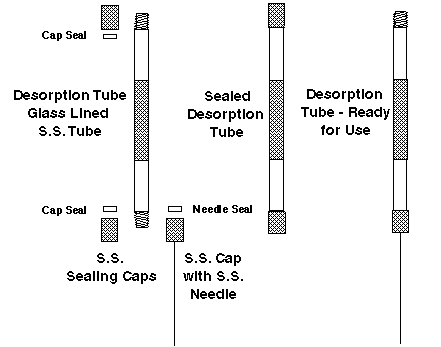
Figure 8 - Desorption Tubes
The Glass Lined Stainless Steel Desorption Tubes are available in two inside diameters, i.e. 3 mm and 4 mm (Figures # 8 & #9). Each tube is 4.0Ó long by 1/4Ó diameter and are threaded on both ends. After conditioning and sample loading, the ends of the tubes are fitted with stainless steel caps with seals to maintain the integrity of the medium and sample. Standard 6mm septa seals, or the PTFE and Viton® seals can be used in the caps to make the seal. These same threads on the Desorption Tube also provide the means of connecting the Desorption Tubes to the Desorption Connector Tube and the injecting syringe needle utilizing the 4 types of seals.
Samples to be analyzed are collected on GLT Desorption Tubes packed with a porous polymer such as Tenax TA or activated charcoal or combination which has been previously packed and conditioned in the tube. The GLT Desorption Tubes are rugged for transportability and use (unlike other glass sample tubes). The glass lining provides for an inert surface for your samples and can be silylated if so desired. After sample collection the GLT Desorption Tubes are capped with stainless steel caps with PTFE or silicone liners to maintain sample integrity during storage and transportation. When ready for analysis, the caps are removed and a stainless steel needle on a cap is attached to the Desorption Tube. The collected sample can then be desorbed directly into the injection port of the GC.
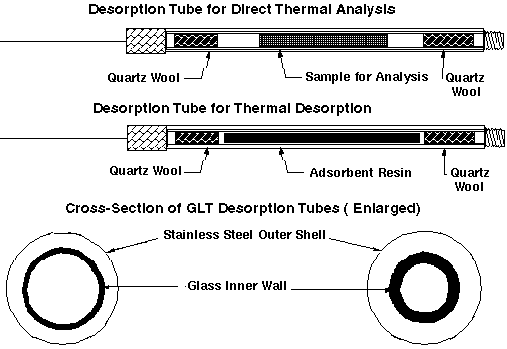
Figure 9 - GLT Desorption Tubes
General Methodology
A wide variety of manufacturers and model of GC's are available on which the Short Path Thermal Desorption System can be installed. These instruments exhibit a wide spectrum of flow system designs which when combined with the wide variety of injection techniques, such as direct injection, split, splitless, and cool-on-column result in many different ways to operate the Short Path Thermal Desorption System. Considerable variation in the configuration of setup is anticipated from one instrument to another. The type of analysis and its unique problems in analyzing, will affect the methodology developed to analyze these samples using the Short Path Thermal Desorption System. As a result no one methodology can be outlined to suit all situations.
GC Carrier Flow
When the flow through the Desorption System is passed into the injection port of the GC, the operator must decide the fate of the normal GC carrier gas flow. Is the GC carrier gas permitted to flow in addition to the Desorption carrier flow, or is it to be shut off? This can affect split ratios and the flow rate through the GC column. After desorption is complete, is the desorber tube and needle to remain in the injection port to provide carrier gas flow to the GC, or should it be removed and the conventional GC carrier gas flow be permitted to perform its normal functions for which the GC injection flow system was designed? The design and flow patterns particular to the specific GC model must be considered by the user in determining the best operating parameters. In most cases there may be two or more acceptable methods of setup.
The GC column should be capable of being cooled to subambient temperatures of between 0 degrees C and -40 degrees C. This is required to permit the desorbed samples to be concentrated and collected in a narrow band at the front of the GC column or in the injection port of the GC. This can be accomplished by using a GC equipped with subambient cooling capability (liquid nitrogen or CO2). Temperature programming is required to enable the system to be heated for the subsequent analysis by the GC and detector system. Some analysis may be accomplished by collecting samples at room temperature.
The specific GC column and temperature program employed will be dependent on the specific compounds being analyzed. Generally, a nonpolar stationary phase (e.g. DB1, SE-30, OV-1) temperature programmed from -30 degrees C to 250 degrees C at 4-10 degrees /minute will be suitable. Capillary column dimensions of 0.32mm I.D. and 60 meters long are generally appropriate although other I.D.'s and lengths may be sufficient in many cases.
Often a short precolumn of approximately one meter in length by 0.53mm I.D. at the injection port end of the GC column, will help prevent the plugging of the system by water, which is present in most samples, and which is desorbed into the GC. The larger I.D. of this precolumn permits a larger surface area for the sample to collect with less chance of plugging by water vapors condensing at its end. Samples with high water content should be avoided when possible.
 Inventors
& Designers of the Short Path Thermal Desorption System: (left to right)
Sandy Overton, John Manura, Thomas Hartman, John Manos, Chris Baker.
Inventors
& Designers of the Short Path Thermal Desorption System: (left to right)
Sandy Overton, John Manura, Thomas Hartman, John Manos, Chris Baker.
Viton® is a registered trademark of DuPont Dow Elastomers

